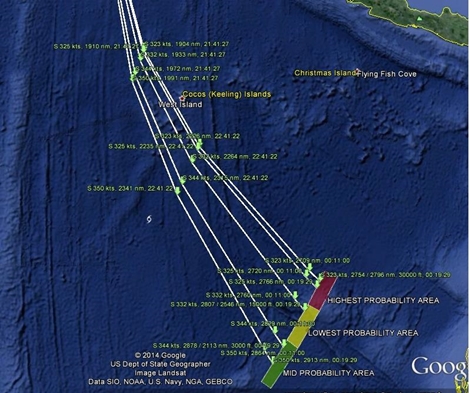MH370 Rescue coordination centres should have been alerted of a possible emergency within 30 minutes of losing contact with an aircraft, according to the International Civil Aviation Organisation (ICAO) guidelines.
This lends credence to criticism that Malaysia had been slow in taking about four hours to inform the Kuala Lumpur Air Search and Rescue Centre (ARCC) that MH370 had gone missing in the early hours of March 8 with 239 persons on board.
 The regulations are laid out in Annex 11 and Annex 12 of the Chicago Convention on International Civil Aviation, which deals with air traffic control services and search and rescue operations respectively.
The regulations are laid out in Annex 11 and Annex 12 of the Chicago Convention on International Civil Aviation, which deals with air traffic control services and search and rescue operations respectively.
The provisions under Annex 11 spells out three phases for an air emergency as well as rules on when to declare them. These are called: ‘Uncertain’, ‘Alert’, and ‘Distress’ in increasing order of urgency.
The safety of an aircraft is considered to be “uncertain” if it did not establish communications within 30 minutes of the time when such communications are expected, or within 30 minutes of the first failed attempt to communicate with the aircraft.
This is unless “no doubt exists” that the aircraft and occupants are safe despite the lack of communication.
Under Annex 12, the ARCC is supposed to respond by cooperating with relevant agencies so that any incoming reports about the aircraft can be evaluated quickly.
If further attempts to contact the aircraft fails, Annex 11 further stipulates that the emergency is supposed to be escalated to the ‘Alert’ phase, and then finally to ‘Distress’ if more attempts fail.
When on alert, the ARCC is supposed to notify search and rescue teams, and they are mobilised when the emergency enters the ‘Distress’ phase.
The last contact with MH370 was via radar at 1.21am on March 8, and it took 17 minutes for air traffic controllers in Ho Chi Minh City to notify their Kuala Lumpur counterparts that it had no communication with the aircraft.
The Kuala Lumpur ARCC was only set into motion at 5.30am.
In the interim four hours, air traffic controllers in Kuala Lumpur, Ho Chi Minh, Cambodia, Singapore and others communicated with each other looking for information on the aircraft.
Hisham: France took longer in 2009
Confusingly, MAS told Kuala Lumpur air traffic controllers that it is communicating with MH370 and it is flying in Cambodian airspace at about 2.15am, but clarified at 3.30am that the information was based on a projected flight path and not reliable .
When asked to comment on the delay yesterday, Acting Transport Minister Hishammuddin Hussien ( centre in picture ) replied that it took six hours for rescuers to be notified during the Air France (AF) Flight 447 crash in 2009.
“It is not for us to discuss and decide here because I had informed that in the case of Air France Flight 447, it took them six to seven hours to respond.
“Therefore the benchmark for response time is different based on prevailing conditions. If we want to discuss this via the media, everyone has their opinion,” he said, adding that he would leave it to experts investigating the incident to determine whether the delay was acceptable.
According to the investigation report by French authorities, the actual time taken to notify rescue coordination centres about AF447 was 6 hours and 30 minutes since the last communication.
However, the report appears to view this as a problem, and made several recommendations calling for improved communications systems for air traffic controllers, and better coordination of search and rescue organisations, especially in maritime or remote regions.

